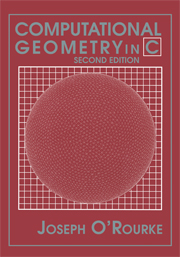1 - Polygon Triangulation
Published online by Cambridge University Press: 05 June 2012
Summary
ART GALLERY THEOREMS
Polygons
Much of computational geometry performs its computations on geometrical objects known as polygons. Polygons are a convenient representation for many real-world objects; convenient both in that an abstract polygon is often an accurate model of real objects and in that it is easily manipulated computationally. Examples of their use include representing shapes of individual letters for automatic character recognition, of an obstacle to be avoided in a robot's environment, or of a piece of a solid object to be displayed on a graphics screen. But polygons can be rather complicated objects, and often a need arises to view them as composed of simpler pieces. This leads to the topic of this and the next chapter: partitioning polygons.
Definition of a Polygon
A polygon is the region of a plane bounded by a finite collection of line segments forming a simple closed curve. Pinning down a precise meaning for the phrase “simple closed curve” is unfortunately a bit difficult. A topologist would say that it is the homeomorphic image of a circle, meaning that it is a certain deformation of a circle. We will avoid topology for now and approach a definition in a more pedestrian manner, as follows.
Let v0, v1, v2, …, vn-1 be n points in the plane. Here and throughout the book, all index arithmetic will be mod n, implying a cyclic ordering of the points, with v0 following vn-1, since (n - 1) + 1 = n = 0(modn).
Information
- Type
- Chapter
- Information
- Computational Geometry in C , pp. 1 - 43Publisher: Cambridge University PressPrint publication year: 1998
Accessibility standard: Unknown
Why this information is here
This section outlines the accessibility features of this content - including support for screen readers, full keyboard navigation and high-contrast display options. This may not be relevant for you.Accessibility Information
- 1
- Cited by
